When you think of piranhas, the first image that probably comes to mind is their sharp teeth and their reputation as dangerous predators of the Amazon River. Known for their ability to swarm and devour prey quickly, piranhas have earned a fierce reputation. But here’s a question that might surprise you: Do people actually eat piranhas? The answer is yes, and it’s more common than you might think. Let’s dive into this unique culinary topic and learn about piranhas as food, their taste, health benefits, and how they’re prepared.
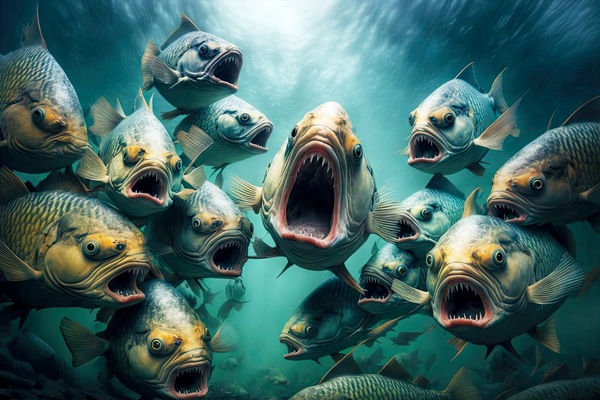
Yes, people do eat piranhas, particularly in the Amazon regions of South America, including countries like Brazil, Peru, and Colombia. While piranhas may sound intimidating to most, in the Amazon, they are a regular part of the local diet and are caught both by locals and adventurous tourists who want to taste this exotic fish.
Eating piranhas might sound like an unusual choice, but locals have been consuming them for generations. The fish is readily available in local rivers, making it a convenient food source, especially for communities that rely heavily on fishing for sustenance. In fact, in certain regions, eating piranhas is as common as eating any other type of fish.
For those curious about the flavor, piranhas have a taste similar to white fish, though they have a bit of a “gamey” or earthy undertone, possibly due to their diet and environment. The meat is white, flaky, and mild-tasting, which makes it appealing to many who might be hesitant to try them at first. Some say it’s comparable to tilapia or even bass, but with a slightly unique flavor profile that sets it apart.
Piranhas offer a range of health benefits, just like many other fish. They are high in protein, low in fat, and contain essential nutrients like omega-3 fatty acids, which support heart health and brain function. Here’s a closer look at the potential nutritional perks:
High-Quality Protein: Piranhas provide a good amount of lean protein, essential for muscle building and tissue repair.
Omega-3 Fatty Acids: Though they may not contain as much as cold-water fish, piranhas still offer omega-3s that benefit heart and brain health.
Low in Saturated Fat: Like most fish, piranhas are low in saturated fats, making them a healthy alternative to red meat.
Essential Minerals: Piranhas contain minerals like iron and phosphorus, important for blood health and bone strength.
If you’re wondering how piranhas are prepared, there are several popular methods, depending on the region and the cook’s preference. Locals have perfected cooking techniques that enhance the flavor and texture of the fish. Here are a few common ways to cook piranhas:
Grilling: Grilling piranhas is a popular method that gives the fish a smoky flavor. The fish is often seasoned with simple spices, then grilled over an open flame. This method is popular among both locals and tourists who want to try something authentic.
Frying: Fried piranha is a tasty treat, usually served with a side of rice, vegetables, or plantains. The fish is typically breaded or seasoned before being fried until golden and crispy.
Soups and Stews: Piranhas are also used in soups and stews, especially in the Amazon region. Piranha soup is a flavorful dish, often seasoned with herbs and local spices to create a comforting, protein-rich meal.
Eating piranhas is more than just a meal; it’s a cultural experience in the Amazon region. In some places, it’s even seen as a rite of passage for visitors, who are encouraged to catch and cook their own piranha to get a taste of the Amazonian lifestyle. For locals, piranhas are simply a part of their everyday diet. This practice reflects the deep connection between Amazonian people and the river ecosystem, where they view piranhas as another valuable resource.
Some people might be hesitant to eat piranhas due to their aggressive reputation. However, despite being carnivorous, piranhas aren’t harmful when served on a plate! Additionally, people might wonder if consuming piranhas impacts the environment. Fortunately, piranha populations are abundant in the Amazon, and their consumption by local communities is sustainable, especially when responsibly fished.
If you’re curious to try piranhas but aren’t planning a trip to South America, you might find it challenging to locate them elsewhere. Most restaurants outside the Amazon don’t offer piranhas on the menu, partly due to their exotic nature and the difficulty of sourcing them. However, some specialty restaurants might occasionally feature exotic Amazonian dishes, including piranha, so it’s worth checking if you have a taste for the adventurous.
Eating piranhas might seem like a daring choice, but they’re actually a nutritious and sustainable food option in the Amazon. For those willing to try something new, piranhas offer a mild, enjoyable flavor and a unique culinary experience that can make your journey through the Amazon even more memorable.
So, if you ever find yourself in the Amazon, why not give piranhas a try? Not only will you be partaking in a local tradition, but you’ll also get a taste of the region’s rich biodiversity—literally!

Piranhas: Fascinating Facts About the Amazon’s Most Infamous Fish
Piranhas are some of the most intriguing and misunderstood fish in the world. Known for their sharp teeth and reputation as fearsome hunters, these freshwater fish are native to the rivers and lakes of South America, particularly the Amazon River Basin. Let’s explore the details of these remarkable creatures, their physical traits, behavior, diet, and the myths that surround them.
Piranhas belong to the family Serrasalmidae, a group of fish that also includes pacus and silver dollars. There are over 60 recognized species of piranhas, varying widely in size, color, and behavior. They have been swimming in South American rivers for millions of years and play an essential role in the ecosystem.
While piranhas are best known for their carnivorous habits, not all piranhas are purely meat-eaters. Some species are omnivores, feeding on both plants and animals, while others mainly eat seeds or other vegetation.
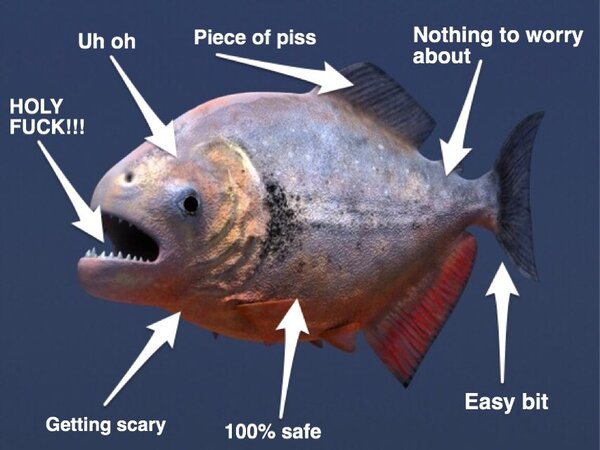
Piranhas are typically small to medium-sized fish, with most species growing between 6 to 10 inches long, though some, like the black piranha, can reach up to 16 inches. They have distinctive physical traits that make them easily recognizable:
Razor-Sharp Teeth: Their interlocking, triangular teeth are among their most notable features, designed for tearing flesh. These teeth are so sharp that they can easily pierce the skin of their prey.
Strong Jaws: Piranhas have powerful jaws, especially for their size. The black piranha, in particular, has an incredibly strong bite force relative to its body size.
Silvery to Dark Coloring: Piranhas come in different colors, from silvery-gray to dark red or black, often with a slightly shiny or metallic appearance. Their colors help them blend into their surroundings, making it easier to ambush prey.
Piranhas are primarily found in the rivers, lakes, and floodplains of the Amazon Basin, though some species are also present in the Orinoco River in Venezuela, the Paraná River, and other parts of South America. They thrive in warm, freshwater environments and are highly adapted to their specific habitats. Flooded forests and shallow rivers are ideal environments for piranhas, as these areas provide plenty of cover and access to food.
Piranhas have a varied diet, and their eating habits can depend significantly on the species and availability of food. Here’s a look at their typical diet:
Carnivorous Species: Some piranhas are primarily carnivorous, preying on fish, crustaceans, insects, and occasionally small birds or mammals that fall into the water. They are opportunistic feeders, often scavenging when possible.
Omnivorous Species: Many piranhas are omnivores, consuming both meat and plant matter. They might eat fruits, seeds, and even vegetation that falls into the river, which contributes to nutrient cycling within their ecosystem.
Scavengers: Piranhas are notorious for scavenging. If an animal dies in the water, piranhas may swarm to consume the remains. This behavior has given rise to their exaggerated reputation as “flesh-eating” fish.
Piranhas often hunt in groups, but this behavior is more about protection than efficiency in killing prey. In a group, they can protect themselves from larger predators and increase their chances of finding food. When hunting or scavenging, piranhas may appear to go into a feeding frenzy, especially when food is scarce.
Due to movies and popular media, piranhas have gained a reputation as extremely dangerous animals that can strip an animal to the bone in seconds. However, this reputation is largely exaggerated. Here are some common myths and the facts behind them:
Piranhas Constantly Attack Humans: In reality, piranhas are generally shy and avoid humans. They rarely attack unless provoked or extremely hungry. Human attacks by piranhas are uncommon, and fatalities are exceedingly rare.
They Attack in Frenzies at All Times: Piranhas do exhibit frenzy-like behavior, but it usually happens when food is scarce, and a large group finds a single source of food. Most of the time, piranhas are not in this “frenzied” state.
All Piranhas Are Dangerous Carnivores: Not all piranhas are aggressive hunters. Many are omnivores, and some are primarily plant-eaters.
Piranhas play an important role in the Amazonian ecosystem. They help keep populations of other fish species in check, which contributes to biodiversity. As scavengers, they also help to recycle nutrients by consuming dead or dying animals, which aids in maintaining the health of the ecosystem. Their role in the food chain is significant, as they are both predators and prey for larger animals, such as caimans, river dolphins, and larger fish.
In some places, piranhas are kept as exotic pets. However, their aggressive nature and specific needs make them challenging to care for. Many regions restrict the ownership of piranhas due to concerns about their potential to disrupt local ecosystems if released. In an aquarium, piranhas require a large tank, warm water, and specific diets to thrive.
In Amazonian countries like Brazil, Peru, and Colombia, piranhas are a part of the local diet and are commonly fished and prepared as food. While it might sound unusual to outsiders, piranhas are prepared in a variety of ways, including grilling, frying, and using them in soups. The meat is often described as mild and slightly gamey, making it a unique addition to Amazonian cuisine.
Piranhas are far more complex than their Hollywood reputation suggests. While they have earned their place as one of nature’s most fascinating fish, they are not nearly as dangerous to humans as myths would have us believe. From their important role in the Amazon ecosystem to their unique behaviors, piranhas continue to captivate people around the world. Whether as a predator, a pet, or even a meal, piranhas remain an extraordinary subject for exploration and understanding.
Piranhas: Fascinating Facts About the Amazon’s Most Infamous Fish
Piranhas are some of the most intriguing and misunderstood fish in the world. Known for their sharp teeth and reputation as fearsome hunters, these freshwater fish are native to the rivers and lakes of South America, particularly the Amazon River Basin. Let’s explore the details of these remarkable creatures, their physical traits, behavior, diet, and the myths that surround them.
Piranhas belong to the family Serrasalmidae, a group of fish that also includes pacus and silver dollars. There are over 60 recognized species of piranhas, varying widely in size, color, and behavior. They have been swimming in South American rivers for millions of years and play an essential role in the ecosystem.
While piranhas are best known for their carnivorous habits, not all piranhas are purely meat-eaters. Some species are omnivores, feeding on both plants and animals, while others mainly eat seeds or other vegetation.
Piranhas are typically small to medium-sized fish, with most species growing between 6 to 10 inches long, though some, like the black piranha, can reach up to 16 inches. They have distinctive physical traits that make them easily recognizable:
Razor-Sharp Teeth: Their interlocking, triangular teeth are among their most notable features, designed for tearing flesh. These teeth are so sharp that they can easily pierce the skin of their prey.
Strong Jaws: Piranhas have powerful jaws, especially for their size. The black piranha, in particular, has an incredibly strong bite force relative to its body size.
Silvery to Dark Coloring: Piranhas come in different colors, from silvery-gray to dark red or black, often with a slightly shiny or metallic appearance. Their colors help them blend into their surroundings, making it easier to ambush prey.
Piranhas are primarily found in the rivers, lakes, and floodplains of the Amazon Basin, though some species are also present in the Orinoco River in Venezuela, the Paraná River, and other parts of South America. They thrive in warm, freshwater environments and are highly adapted to their specific habitats. Flooded forests and shallow rivers are ideal environments for piranhas, as these areas provide plenty of cover and access to food.
Piranhas have a varied diet, and their eating habits can depend significantly on the species and availability of food. Here’s a look at their typical diet:
Carnivorous Species: Some piranhas are primarily carnivorous, preying on fish, crustaceans, insects, and occasionally small birds or mammals that fall into the water. They are opportunistic feeders, often scavenging when possible.
Omnivorous Species: Many piranhas are omnivores, consuming both meat and plant matter. They might eat fruits, seeds, and even vegetation that falls into the river, which contributes to nutrient cycling within their ecosystem.
Scavengers: Piranhas are notorious for scavenging. If an animal dies in the water, piranhas may swarm to consume the remains. This behavior has given rise to their exaggerated reputation as “flesh-eating” fish.
Piranhas often hunt in groups, but this behavior is more about protection than efficiency in killing prey. In a group, they can protect themselves from larger predators and increase their chances of finding food. When hunting or scavenging, piranhas may appear to go into a feeding frenzy, especially when food is scarce.
Due to movies and popular media, piranhas have gained a reputation as extremely dangerous animals that can strip an animal to the bone in seconds. However, this reputation is largely exaggerated. Here are some common myths and the facts behind them:
Piranhas Constantly Attack Humans: In reality, piranhas are generally shy and avoid humans. They rarely attack unless provoked or extremely hungry. Human attacks by piranhas are uncommon, and fatalities are exceedingly rare.
They Attack in Frenzies at All Times: Piranhas do exhibit frenzy-like behavior, but it usually happens when food is scarce, and a large group finds a single source of food. Most of the time, piranhas are not in this “frenzied” state.
All Piranhas Are Dangerous Carnivores: Not all piranhas are aggressive hunters. Many are omnivores, and some are primarily plant-eaters.
Piranhas play an important role in the Amazonian ecosystem. They help keep populations of other fish species in check, which contributes to biodiversity. As scavengers, they also help to recycle nutrients by consuming dead or dying animals, which aids in maintaining the health of the ecosystem. Their role in the food chain is significant, as they are both predators and prey for larger animals, such as caimans, river dolphins, and larger fish.
In some places, piranhas are kept as exotic pets. However, their aggressive nature and specific needs make them challenging to care for. Many regions restrict the ownership of piranhas due to concerns about their potential to disrupt local ecosystems if released. In an aquarium, piranhas require a large tank, warm water, and specific diets to thrive.
Piranhas are far more complex than their Hollywood reputation suggests. While they have earned their place as one of nature’s most fascinating fish, they are not nearly as dangerous to humans as myths would have us believe. From their important role in the Amazon ecosystem to their unique behaviors, piranhas continue to captivate people around the world. Whether as a predator, a pet, or even a meal, piranhas remain an extraordinary subject for exploration and understanding.
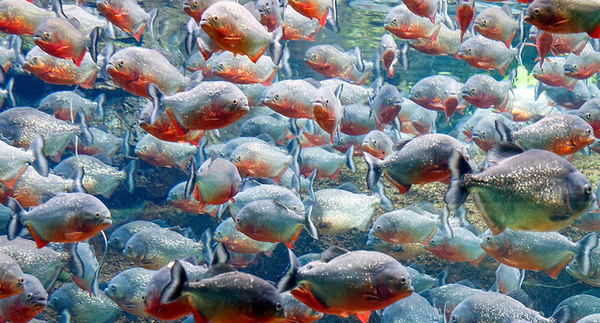
Piranhas vary widely in size, behavior, and dietary habits, with some species being more aggressive and carnivorous than others. Here’s a look at a few notable types of piranhas and an overview of their breeding characteristics:
| Species | Description | Size | Diet | Breeding Characteristics |
|---|---|---|---|---|
| Red-Bellied Piranha | Known for its reddish belly and aggressive feeding behavior | Up to 12 inches | Carnivorous, with occasional plant material | Breeds in pairs; females lay up to 5,000 eggs in shallow, sheltered areas, with both parents guarding the eggs |
| Black Piranha | Larger species with a dark coloration and extremely strong bite force | Up to 16 inches | Primarily carnivorous | Breeding behaviors less understood in the wild, but generally solitary; females lay eggs which hatch in 3–4 days |
| Wimple Piranha | Known for scraping scales off other fish rather than biting flesh | Up to 7 inches | Scale-feeding and omnivorous | Typically breeds in flooded areas during rainy season; juveniles grow rapidly in nutrient-rich waters |
| San Francisco Piranha | Aggressive species from the Paraguay River, often in high-density environments | Up to 10 inches | Carnivorous and omnivorous | Breeding begins in the rainy season; both parents guard the nest, which is built in sandy areas |
| Ruby-Red Piranha | Reddish fins and body, popular in aquariums due to coloration | Up to 8 inches | Carnivorous | Breeding occurs during wet season; males attract females by cleaning and preparing a nest site |
| Gold Piranha | Distinguished by a golden hue and more solitary nature | Up to 14 inches | Carnivorous | Less known about wild breeding; often observed guarding eggs and fry, especially in shallow areas |
Piranhas typically breed in the rainy season when river levels rise, creating flooded areas with plenty of vegetation. These flooded environments provide shelter and nutrients, essential for the young piranhas to grow rapidly. Here are some common breeding traits:
Pairing and Nesting: Most piranhas form pairs during the breeding season. Males often prepare a nesting area in sandy or muddy bottoms, where females lay eggs.
Egg-Laying: The number of eggs varies greatly among species but can range from a few hundred to several thousand. Eggs are laid in nests in shallow, sheltered areas to avoid predation.
Parental Care: Unlike many fish species, some piranhas display a degree of parental care. Both parents may guard the eggs and fry to protect them from other fish and predators.
Egg Incubation: Depending on the water temperature, piranha eggs can hatch in about 2–4 days. The fry (young piranhas) feed on microscopic organisms until they are large enough to hunt.
Growth: Young piranhas grow rapidly in the nutrient-rich floodwaters, which helps them avoid predation as they develop into juvenile fish.
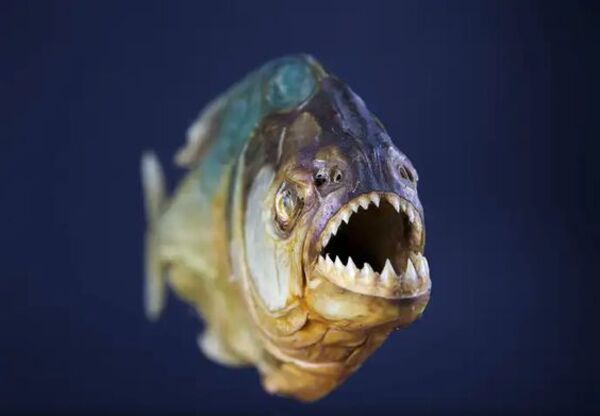
Piranhas are freshwater fish mainly found in the rivers of South America, such as the Amazon, Orinoco, and Parana rivers. Their primary activities include:
Foraging and Hunting: While often considered fierce hunters, piranhas are primarily opportunistic feeders. They eat a variety of foods including fish, crustaceans, insects, plants, and occasionally, carrion (dead animals). Some species, like the red-bellied piranha, are known for hunting in packs to scavenge meat.
Schooling: Piranhas tend to form groups or schools, often as a defensive measure to protect against larger predators. This schooling behavior also aids in hunting and foraging in groups, which makes it easier for them to locate food sources.
Biting and Feeding: Piranhas bite to secure food, defend territory, or protect themselves. In terms of feeding, they use their sharp teeth to tear chunks of flesh or scales from their prey.

Piranhas have a powerful bite relative to their body size. The black piranha (Serrasalmus rhombeus), in particular, has an extraordinary bite strength. Studies show that:
Bite Force Measurement: Black piranhas can generate a bite force of over 70 pounds per square inch (psi), which is nearly three times the strength of an American alligator relative to body size.
Strong Jaw Muscles: Piranhas have highly developed jaw muscles and specialized sharp, triangular teeth. This allows them to slice through flesh and bone with remarkable efficiency.
Adaptation for Feeding: Their bite strength and razor-like teeth make them effective in quickly tearing flesh from prey or carcasses, making them highly effective in group feeding situations.
Despite their powerful bite, it’s worth noting that not all species are aggressive or as strong as the black piranha. Many are far less powerful and may rely on other forms of feeding.
Piranhas have developed aggressive tendencies due to various evolutionary factors, but not all species are inherently aggressive. The factors contributing to piranha aggression include:
Competition for Food: In the dense ecosystems of South American rivers, competition for food is intense. Piranhas have evolved to be opportunistic feeders, often seizing any chance for a quick meal, especially when food is scarce.
Defense Mechanism: Aggressiveness in piranhas is partially a defense mechanism. By schooling and acting aggressively, they can deter predators and defend themselves from potential threats.
Reproductive Behavior: During the breeding season, piranhas can become more territorial and defensive, particularly around their nests or spawning sites. This behavior is a natural defense to protect their eggs and young from other fish.
Group Feeding Frenzies: While rare, “feeding frenzies” occur when food sources are limited, or if a large quantity of prey or meat is introduced suddenly. These frenzies can appear highly aggressive, as piranhas rapidly strip the food in a coordinated manner.
Overall, piranhas are often cautious and will avoid risky confrontations unless necessary. Their reputation for aggression is largely due to rare instances of feeding frenzies.
Piranhas pose a minimal threat to humans, though there are situations where they could potentially be dangerous:
Human Attacks Are Rare: Documented cases of piranhas harming humans are rare and typically involve provoked situations, such as when piranhas feel threatened or if people enter their nesting areas during the breeding season.
Misconceptions and Media: Piranhas have been sensationalized in media, often portrayed as creatures that will immediately attack any intruder. However, piranhas are more likely to flee from humans than attack them.
Situational Aggression: In cases of extreme food scarcity or drought, piranhas may exhibit more aggressive feeding behaviors. Swimmers or fishermen may occasionally get nipped, but serious injuries are unusual.
Minor Injuries Possible: If a person is bitten by a piranha, it’s usually due to accidental contact or provocation. In the rare event of a bite, the injury is typically minor, as piranhas often bite once and release rather than sustaining an attack.
In summary, while piranhas are not generally harmful to humans, understanding their natural behavior and respecting their habitats can minimize risks. In most cases, piranhas prefer to avoid confrontation with larger animals, including people.
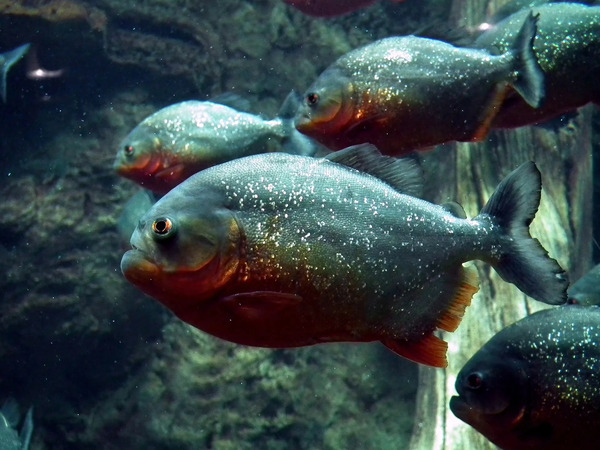
The idea of piranhas as deadly killers is largely a product of myths, sensationalized media, and exaggerated accounts. While piranhas possess sharp teeth and can bite with considerable force, the reality of their threat to humans is far more nuanced. Here’s a thorough exploration of the factors that contribute to piranhas’ potential danger to humans and what science says about the actual risks involved.
Piranhas are primarily opportunistic feeders and tend to avoid humans. Their diet generally consists of fish, crustaceans, insects, plants, and occasionally carrion (dead animals). Most piranha species, even aggressive ones like the red-bellied piranha, are cautious of large animals and humans, preferring to avoid confrontation.
In natural settings, piranhas rarely initiate attacks on humans. They are far more interested in avoiding potential threats than actively engaging with something much larger than themselves. The notion of piranhas instantly swarming and consuming a human is mostly a fictional portrayal.
While piranhas are not generally dangerous to humans, there are certain situations where they may become more aggressive or defensive:
Food Scarcity and Drought Conditions: In periods of severe food shortage or drought, piranhas’ feeding habits can become more desperate. Rivers may shrink in size, causing large numbers of piranhas to gather in confined areas with limited food, which could lead to heightened aggression.
Presence of Blood or Distress: Piranhas are attracted to the smell of blood or signs of distress in the water, which might trigger their feeding response. While they may investigate, piranhas generally won’t swarm or attack unless they’re particularly agitated or hungry.
Breeding Season: During the breeding season, some piranha species become territorial and more aggressive to protect their nests and eggs. If a human enters their nesting area, they might bite in defense, but this is more of a warning than a life-threatening attack.
Piranhas, particularly species like the black piranha, possess one of the strongest bites relative to their body size. However, while a piranha’s bite is sharp and strong enough to break through flesh, it’s usually not deep or sustained enough to cause fatal injuries to a human. A bite may cause:
Minor Injury: A typical piranha bite might result in minor lacerations, comparable to a deep scratch or small puncture.
Localized Pain and Bleeding: Due to the sharp teeth, bites can be painful and cause bleeding. However, they are generally shallow.
Rare Infection Risk: If untreated, an open wound from a piranha bite could potentially become infected, but this is manageable with basic first aid.
Most piranhas will bite once as a deterrent and then swim away, rather than continuing to bite or swarming in a group.
There are extremely rare, documented cases where piranhas have contributed to human fatalities, but these are almost always indirect or accidental:
Drowning Incidents: In some instances, people who have drowned or been seriously injured in piranha-populated waters may suffer post-mortem bites. Piranhas are known to scavenge on dead animals, and a drowned person might appear as a food source.
Large Feeding Frenzies: Feeding frenzies are uncommon but can happen when a large amount of food enters the water suddenly. If someone enters the water at that exact moment, they might suffer bites. However, such occurrences are extremely rare, and in nearly all cases, the person is not killed by piranhas alone.
Environmental Factors: Some reports of severe injuries involve rare conditions, such as extreme drought, high piranha population density, or unusually aggressive piranha behavior caused by environmental stress. Even in these cases, fatalities are exceedingly uncommon.
Scientific studies and local accounts from regions where piranhas are abundant indicate that piranhas do not pose a serious threat to humans in typical situations. Native people in piranha-rich areas often swim in the same waters without incident. Researchers also handle piranhas regularly with minimal injury risk.
Overall, piranhas are cautious creatures that avoid unnecessary risks, including potential interactions with humans. Most cases of human bites are isolated incidents, often involving defensive behaviors rather than aggressive feeding.
While piranhas are theoretically capable of causing injury, the likelihood of a fatal encounter is extremely low. Piranhas generally do not seek out humans as prey, and serious injuries are rare and often avoidable. By exercising caution—avoiding areas with high piranha activity during droughts or breeding seasons, and steering clear of behaviors that may attract piranhas, such as entering the water with open wounds—humans can safely coexist with these fish.
In summary, while piranhas have powerful bites and can be aggressive under specific circumstances, they are not the deadly threat to humans that they are often portrayed to be.
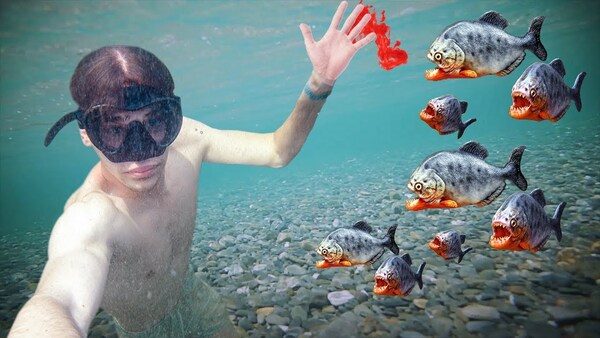
Piranhas, known for their fierce image and sharp teeth, are iconic fish that have inspired artists, scientists, and even medical researchers. This fascination stems from both their unique characteristics and their cultural symbolism, leading to an intersection of art, scientific study, and innovative medical applications. Here’s an in-depth look at each of these dimensions.
Piranhas have found a lasting place in art across various media, from painting and sculpture to films and digital art. Artists are drawn to piranhas for their distinct appearance—razor-sharp teeth, muscular bodies, and intense, predatory gaze—representing power, mystery, and the wild unpredictability of nature. Some prominent themes and forms in piranha art include:
Symbolism in Visual Art: Piranhas often appear in visual art as symbols of aggression, fear, and sometimes survival. Paintings and sculptures capture them in action, emphasizing their sharp teeth and powerful movements to evoke both beauty and danger. For instance, Latin American artists may use piranhas to represent nature’s raw power, as these fish are native to South American rivers and are deeply embedded in local folklore.
Film and Digital Media: Piranhas have also become a staple in horror and thriller films, often exaggerated as ferocious killers in works like Piranha 3D. This portrayal, though far from reality, has cemented their reputation as symbols of dread, turning them into cultural icons with lasting impact.
Modern Installations and Digital Art: Recently, artists have experimented with interactive installations and digital renderings that allow viewers to experience the world of a piranha school, creating immersive environments. These pieces explore themes of biodiversity and environmental conservation, reminding viewers of the balance between predator and ecosystem.
Piranhas are of significant interest to scientists for various reasons, from their behavior and social dynamics to their formidable bite strength. Key areas of scientific research include:
Behavioral Studies: Research into piranha social behavior reveals complex interactions within schools. While often depicted as aggressive, many piranha species display social structures that emphasize cooperation, such as forming groups for protection from larger predators. Understanding these social behaviors helps researchers learn about survival tactics in aquatic environments.
Bite Force Analysis: The study of piranhas’ bite strength, particularly that of the black piranha (Serrasalmus rhombeus), has drawn attention due to its impressive power relative to body size. Researchers use specialized instruments to measure the force and anatomy behind the piranha’s bite, gaining insights that can be applied to both robotics and biomechanical studies.
Ecosystem Impact: Piranhas play a key role in river ecosystems, primarily as scavengers and mid-level predators that help maintain balance. Ecologists study their impact on prey populations, which sheds light on food chain dynamics in Amazonian rivers. Such research contributes to broader conservation efforts, as it highlights the importance of preserving these often-misunderstood fish within their natural habitats.
While piranhas themselves are not commonly used in medicine, their unique traits have inspired innovative medical research and applications in fields such as surgery and dentistry.
Inspiration for Surgical Tools: Piranhas’ sharp, durable teeth and efficient jaw structure have inspired the development of cutting tools for surgery. Scientists and engineers study the composition and mechanics of piranha teeth to design surgical scalpels and bone-cutting devices that mimic the fish's effective biting mechanism. This allows for more precise, minimally invasive incisions, especially in orthopedic surgery.
Dental Research and Materials: Piranhas’ teeth are continuously replaced throughout their lives, offering a model for regenerative and durable dental materials. Researchers examine the composition of piranha teeth—primarily enamel and dentine—for potential advancements in tooth implants and restorative materials that resist wear and maintain sharpness over time.
Bio-Inspired Robotics: The muscle and jaw mechanisms of piranhas are studied in biomechanics to develop robotic systems that mimic their high force output in a compact size. This research is valuable for designing robotic grippers and cutters used in surgical robotics, enabling greater precision and adaptability in delicate procedures.
The multifaceted interest in piranhas spans artistic expression, ecological research, and even the cutting edge of medical technology. In art, piranhas represent raw power and survival, frequently embodying themes of nature's beauty and peril. Scientifically, they offer insights into social behavior, biomechanics, and ecological balance, contributing to our understanding of aquatic ecosystems. In the medical field, the design and functionality of their jaws and teeth inspire innovations in surgical tools, dental materials, and robotics, demonstrating that these fascinating fish have potential benefits far beyond their river habitats. Piranhas, therefore, are more than just "dangerous" fish; they are creatures that connect us to nature, inspire scientific discovery, and advance modern medicine.
animal tags: piranhas
We created this article in conjunction with AI technology, then made sure it was fact-checked and edited by a Animals Top editor.